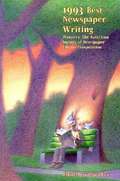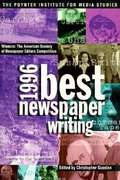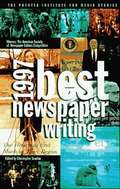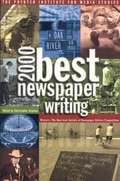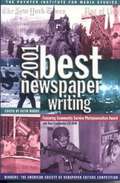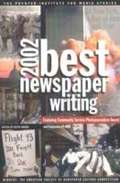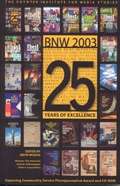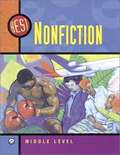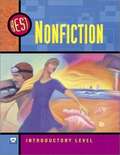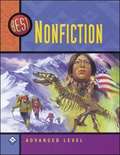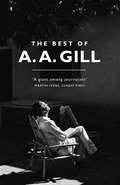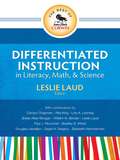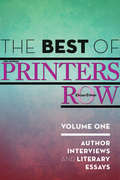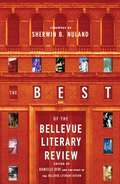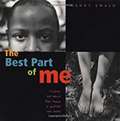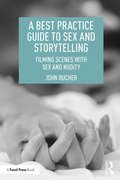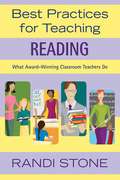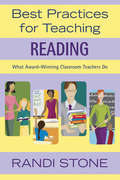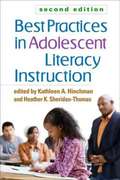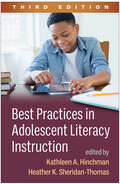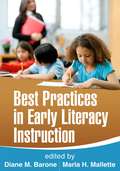- Table View
- List View
Best Newspaper Writing 1993
by Don FryBest Newspaper writing 1993, winners of The American Society of Newspaper Editors Competition.
Best Newspaper Writing 1995
by Christopher ScanlanThis is a compilation of writings by the winners of the American Society of Newspaper Editors Competition for 1995.
Best Newspaper Writing 1996
by Christopher ScanlanBest Newspaper Writing 1996 celebrates the winners of the American Society of Newspaper Editors' Distinguished Writing Awards, including the Jesse Laventhol Awards, created to honor deadline reporting. It includes interviews with the winners about their craft by Christopher Scanlan, Aly Colon, Karen Brown Dunlap, Roy Peter Clark, and Keith Woods of the Poynter Institute faculty; the work of other writers who share the lessons they learned; study questions useful to students, teachers, and working journalists; a bibliography; and essays to help you improve your own writing.
Best Newspaper Writing 1997
by Christopher Scanlan"Best Newspaper Writing 1997" celebrates the winners of the ASNE's Distinguished Writing Awards, including the Jesse Laventhol Awards, created to honor deadline reporting. It includes interviews with the winners about their craft; the work of 17 other writers who share the lessons they learned; study questions useful to students, teachers, and working journalists; a bibliography; and essays to help readers improve their writing.
Best Newspaper Writing 1998
by Christopher ScanlanBest Newspaper Writing for 1998 celebrates the winners of the American Society of Newspaper Editors Distinguished Writing Awards and highlights the best newspaper stories of 1998.
Best Newspaper Writing 1999
by Christopher ScanlanBest Newspaper Writing 1999 celebrates the winners of the ASNE's Distinguished Writing Awards, including the Jesse Laventhol Awards, created to honor deadline reporting. It includes interviews with the winners about their craft; the work of 17 other writers who share the lessons they learned; study questions useful to students, teachers, and working journalists; a bibliography; and essays to help readers improve their writing.
Best Newspaper Writing 2000
by Christopher ScanlanThis volume celebrates the winners of the ASNE's Distinguished Writing Awards, honoring deadline reporting, interviews with the winners and work of 13 other writers, sharing lessons they learned, with study questions useful to students, teachers, and journalists.
Best Newspaper Writing 2001
by Keith WoodsBest Newspaper Writing 2001 celebrates the winners of the American Society of Newspaper Editors Distinguished Writing Awards including the Jesse Laventhol Prizes, created to honor deadline reporting.
Best Newspaper Writing 2002
by Keith WoodsBest Newspaper Writing 2002 celebrates the winners of the ASNE Distinguished Writing Awards, including the Jesse Laventhol Prizes honoring deadline reporting. N.R. Kleinfeld of the New York Times reconstructed the morning of Sept. 11 with stories and stunning details. Jim Dwyer's short stories in the New York Times, resurrected from the smallest pieces of Sept. 11 debris, accomplish a feat that Dwyer himself describes in one of his poignant stories. The Wall Street Journal staff, amid a cloud of personal grief and national uncertainty, produced stories so stirring, encompassing, and complete that they remained relevant and vibrant long after Sept. 11. John McCormick, an editorial writer for the Chicago Tribune, displays amazing range -- from the contradictions of praying for peace amid war in Afghanistan, to a tribute to a murdered Chicago cop. Steve Lopez's storytelling always surprises, whether he's chronicling the unfolding tragedy of Sept. 11, or knocking back a six-pack of beer and a dozen doughnuts in the name of journalistic inquiry. Anne Hull of the Washington Post explores the gentrification of a neighborhood and the aftershocks of Sept. 11. Ellen Barry of the Boston Globe writes of the "Lost Boys" of Sudan, and their odyssey from African cattle herders to urban teens. J. Albert Diaz of the Miami, Herald captures the elusive concept of the American Dream.
Best Newspaper Writing 2003
by Keith WoodsBest Newspaper Writing 2003, the 25th anniversary of this prestigious series' publication, celebrates the winners of the ASNE Distinguished Writing Awards, including the Jesse Laventhol Prizes honoring deadline reporting.
Best Newspaper Writing 2005
by Aly ColónThe Poynter Institute once again brings you the year's best newswriting and community service photojournalism, showcasing the winners and finalists of the American Society of Newspaper Editors annual competition. The perfect reader for aspiring journalists, Best Newspaper Writing 2005 offers a wide array of exemplary writing and photojournalism, providing quality models students can analyze and emulate.
Best Nonfiction: 7 Selections for Young People with Lessons for Teaching the Basic Elements of Nonfiction
by Christine Lind Orciuch Theodore KnightThe Best Series is a fresh and innovative way to introduce and study genre-specific literature in your classroom. Students can explore and gain appreciation for exceptional and diverse writings in nonfiction.
Best Nonfiction: Introductory Level
by Christine Lund Orciuch Theodore KnightThe Best series collects superb nonfiction, play scripts, poetry, short stories, and stand-alone chapters of longer works, so you can quickly find well-crafted selections that reflect student interests. Best of all, we've tailored the series to three reading levels, making it the perfect tool for reaching out to students of any ability who aren't succeeding with more traditional anthologies.
Best Nonfiction Advanced Level: 7 Selections for Young People with Lessons for Teaching the Basic Elements of Nonfiction
by Christine Lund Orciuch Theodore KnightThe Best Series is a fresh and innovative way to introduce and study genre-specific literature in your classroom. Students can explore and gain appreciation for exceptional and diverse writings in nonfiction. This enriching series strengthens students' reading and writing skills and literary techniques.
The Best of A. A. Gill
by Adrian GillFor over twenty years, people turned to A. A. Gill's columns every Sunday - for his fearlessness, his perception, and the laughter-and-tear-provoking one-liners - but mostly because he was the best. 'By miles the most brilliant journalist of our age', as Lynn Barber put it. This is the definitive collection of a voice that was silenced too early but that can still make us look at the world in new and surprising ways.In the words of Andrew Marr, A.. A. Gill was 'a golden writer'. There was nothing that he couldn't illuminate with his dazzling prose. Wherever he was - at home or abroad - he found the human story, brought it to vivid life, and rendered it with fierce honesty and bracing compassion. And he was just as truthful about himself. There have been various collections of A. A. Gill's journalism - individual compilations of his restaurant and TV criticism, of his travel writing and his extraordinary feature articles. This book showcasesthe very best of his work: the peerlessly funny criticism, the extraordinarily knowledgeable food writing, assignments throughout the world, and reflections on life, love, and death. Drawn from a range of publications, including the Sunday Times, Vanity Fair, Tatler and Australian Gourmet Traveller, The Ivy Cookbook and his books on England and America, it is by turns hilarious, uplifting, controversial, unflinching, sad, funny and furious.
The Best of Corwin: Differentiated Instruction in Literacy, Math, and Science
by Leslie E. LaudContent-specific DI guidance from the best minds in education In this collection, current research on the most effective differentiation practices for differentiating instruction in literacy, mathematics, and scienceis brought alive through the many strategies and examples. Topics covered include: Reading and writing: A comprehensive array of models for differentiating reading instruction; gradual release of responsibility to accelerate progress; and multi-tiered writing instruction Mathematics: Support for both low- and high-achieving students, including interventions and challenges, and the implementation of RTI in math instruction Science: Models and methods for increasing student achievement through differentiated science inquiry
The Best of Printers Row, Volume One
by Chicago Tribune StaffChicago Tribune's Printers Row: Interviews, Reviews and Features 2012 is a collection of interviews with authors, reviews of the year's best books, and fascinating features published in the Chicago Tribune's weekly Printers Row literary supplement.Early in 2012, the Chicago Tribune launched its "Printers Row" membership program for those who love books, authors, and conversations about the ideas they generate. The centerpiece is a weekly journal that includes author profiles, book reviews, and Printers Row Fiction in a separate booklet. Chicago Tribune's Printers Row: Interviews, Reviews and Features 2012 is composed of engaging, entertaining, and enlightening profiles, book reviews, as well as extended author interviews and features.
The Best of the Bellevue Literary Review
by Danielle Ofri"A kaleidoscope of creativity ... unsentimental and sometimes unpredictable." -Journal of the American Medical Association. Founded just six years ago, Bellevue Literary Review is already widely recognized as a rare forum for emerging and celebrated writers--among them Julia Alvarez, Raphael Campo, Rick Moody, and Abraham Verghese--on issues of health and healing. Gathered here are poignant and prizewinning stories, essays, and poems, the voices of patients and those who care for them, which form the journal's remarkable dialogue on "humanity and the human experience." Danielle Ofri, MD, author of Incidental Findings and Singular Intimacies, is the editor in chief of Bellevue Literary Review.
The Best Part of Me: Children Talk About Their Bodies In Pictures And Words
by Wendy EwaldVarious parts of the body are portrayed in this book.
A Best Practice Guide to Sex and Storytelling: Filming Scenes with Sex and Nudity
by John BucherA great deal of storytelling in film and television involves narratives that include sexual situations and nudity. The increased amount of on-line and streaming content outlets has in turn increased the number of narratives that involve these once-taboo subjects. Often, even though directors and producers desire to handle such issues with professionalism, sets become awkward when producing these scenes. A Best Practice Guide to Sex and Storytelling serves as a helpful tool for guiding creators through these waters. Even as the practice has become more common, the environments in which individuals on both sides of the camera work to create sensitive content have not become any more comfortable. To date, there have been no industry guides and little practical instruction on how to approach such important yet delicate scenes. Sex and Storytelling offers theoretical and practical approaches to creating the most effective content, while honoring the dignity and humanity of everyone involved on-set when sexuality and nudity is a part of the story being told. Drawing on John Bucher’s professional experience in both high- and low-budget environments and including interviews with players from both sides of the camera, this book provides an essential guide to handling sex and nudity for film and television in a professional manner.
Best Practices for Teaching Reading: What Award-Winning Classroom Teachers Do
by Randi StoneFollowing the successful format of the companion volumes for teaching writing, mathematics, science, and social studies, Best Practices for Teaching Reading presents firsthand accounts of outstanding instructional strategies and lessons for teaching reading to students in both elementary and secondary school. Randi Stone brings readers into the classrooms of more than twenty-five award-winning teachers who share their unique and creative strategies for reaching elementary and secondary learners with diverse learning styles and abilities. From getting fourth-grade students excited to study Shakespeare to creating “wonder journals” to incorporating reading in the math classroom, these teachers have tried it all!With forty classroom-tested strategies, Best Practices for Teaching Reading provides practical guidance for building students’ decoding and vocabulary skills while developing their comprehension and motivation for reading. This collection of best practices presents useful tips in getting students to:· Get excited about reading· Make connections between different texts· Become effective writers as well as readers· Use literacy skills across the curriculumVeteran and new teachers alike will find an abundance of fresh ideas to teach reading while helping students build confidence, increase academic achievement, and develop critical thinking skills.
Best Practices for Teaching Reading: What Award-Winning Classroom Teachers Do
by Randi B. StoneWith 40 classroom-tested strategies from award-winning teachers, this book offers guidance for teaching reading to elementary and secondary learners with diverse learning styles and abilities.
Best Practices in Adolescent Literacy Instruction, Second Edition
by Kathleen A. Hinchman Donna E. Alvermann Heather K. Sheridan-ThomasAn authoritative teacher resource and widely adopted text, this book provides a comprehensive overview of adolescent literacy instruction in the era of the Common Core State Standards (CCSS). Leading educators describe effective practices for motivating diverse learners in grades 5-12, building comprehension of multiple types of texts, integrating literacy and content-area instruction, and teaching English language learners and struggling readers. Case examples, lesson-planning ideas, and end-of-chapter discussion questions and activities enhance the utility of the volume. New to This Edition *Extensive CCSS content incorporated throughout the book. *Chapters on disciplinary literacy, text complexity, and differentiated instruction. *Chapters on academic language, writing instruction, history and English/language arts classrooms, and coaching.
Best Practices in Adolescent Literacy Instruction, Third Edition
by Kathleen A. Hinchman Heather K. Sheridan-Thomas Donna E. AlvermannWith 50% new material reflecting current research and pedagogical perspectives, this indispensable course text and teacher resource is now in a thoroughly revised third edition. Leading educators provide a comprehensive picture of reading, writing, and oral language instruction in grades 5–12. Chapters present effective practices for motivating adolescent learners, fostering comprehension of multiple types of texts, developing disciplinary literacies, engaging and celebrating students' sociocultural assets, and supporting English learners and struggling readers. Case examples, lesson-planning ideas, and end-of-chapter discussion questions and activities enhance the utility of the volume. New to This Edition *Chapters on new topics: building multicultural classrooms, Black girls&’ digital literacies, issues of equity and access, and creating inclusive writing communities. *New chapters on core topics: academic language, learning from multiple texts, and reading interventions. *Increased attention to issues of diversity, equity, and inclusion. *The latest knowledge about adolescents' in- and out-of-school literacies.
Best Practices in Early Literacy Instruction
by Marla H. Mallette Diane M. BaroneBringing together prominent scholars, this book shows how 21st-century research and theory can inform everyday instructional practices in early childhood classrooms (PreK-3). Coverage includes foundational topics such as alphabet learning, phonological awareness, oral language development, and learning to write, as well as cutting-edge topics such as digital literacy, informational texts, and response to intervention. Every chapter features guiding questions; an overview of ideas and findings on the topic at hand; specific suggestions for improving instruction, assessment, and/or the classroom environment; and an engrossing example of the practices in action.
